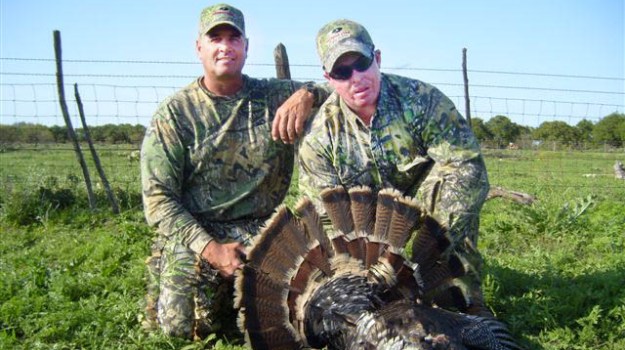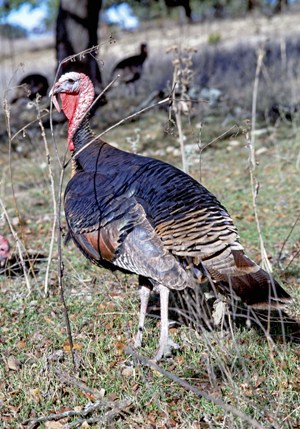
Editor’s Note: Kevin Burleson, near Brody, Texas, who operates the Heart of Texas Bowhunting ranch, offers Rio Grande turkey hunting in the spring for both bowhunters and shotgun hunters. Mossy Oak wanted to know what makes Rio Grande turkeys different from Eastern gobblers, and what hunting these birds is like. Burleson, a Mossy Oak and PSE Pro Staffer, appears on the “Mossy Oak Deer Thugs” TV show on the Pursuit Channel.
We don’t use decoys very often out here in Texas. Instead of setting up on the edge of a field, we like to get back in the bushes away from a strut zone. We try to pull a turkey away from the strut zone into the bushes to find the hen he thinks has been calling to him. This way, we spook pure turkeys. Since, we have so many hens, the hens usually will come in first if we put out decoys. They will start beating up on the hen decoys and run the gobblers off. I only use decoys about 15 percent of the time when I hunt out here in Texas, usually in the late season after most of the hens have been bred and are going to the nest. Decoys tend to produce in the early season when the hens aren’t ready to breed. When we do use them, we put them out on woods roads and lanes where they can be seen from less than 100 yards by an approaching gobbler.
 When we have bowhunters who want to take Rio Grande gobblers, we hunt out of a Mossy Oak pop-up ground blind. Most of our country is open, and you can’t come to full draw without a gobbler seeing you. So generally we try to run and gun and use a ground blind. When we hear a turkey gobble, we try to get close to the bird, and then set-up the blind. The other situation is if we can find some brush that’s thick enough for a bowhunter to hide behind, I’ll get 30 to 50 yards behind the bowhunter and try to call the turkey past the brush. This way the bowhunter can get a shot at the gobbler, while the bird is looking away from him and concentrating on my calling.
When we have bowhunters who want to take Rio Grande gobblers, we hunt out of a Mossy Oak pop-up ground blind. Most of our country is open, and you can’t come to full draw without a gobbler seeing you. So generally we try to run and gun and use a ground blind. When we hear a turkey gobble, we try to get close to the bird, and then set-up the blind. The other situation is if we can find some brush that’s thick enough for a bowhunter to hide behind, I’ll get 30 to 50 yards behind the bowhunter and try to call the turkey past the brush. This way the bowhunter can get a shot at the gobbler, while the bird is looking away from him and concentrating on my calling.
Honestly, taking a turkey without a ground blind in our countryside is very unlikely. We strongly recommend first-time bowhunters for turkeys hunt from ground blinds. A veteran bowhunter who’s taken turkeys in the open knows not to attempt to even draw, unless the turkey has his tail feathers fanned and is looking away. In that one position, the turkey can’t see the hunter draw his bow. However, he still may be able to hear the bowhunter. I tell all my bowhunters, “If you can see that turkey’s head, he’ll see you move.” The only time you can draw your bow is when the turkey’s head is behind a tree or behind his fanned tail feathers. We probably have 30 turkey hunters each year, and I would say only about 10 percent are bowhunters. I think that Mossy Oak’s Ronnie “Cuz” Strickland has the right idea when he says, “Turkeys are meant to die by No. 5’s (shot).” We really encourage our hunters to take their turkeys with shotguns.
Mossy Oak’s Kevin Burleson Says Rio Grande Gobblers Are Different
Where to Shoot a Turkey with a Bow



























